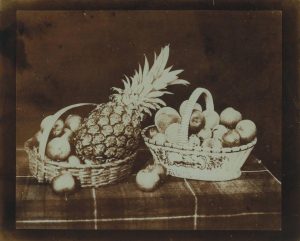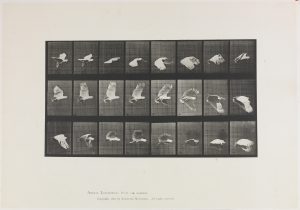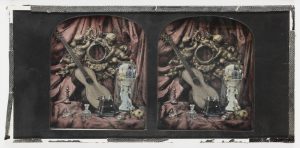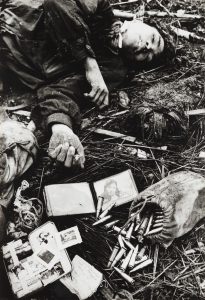One of painting’s chief genres, the ‘still life’, viewed as a historic art form in the world of contemporary painting, has been kept very much alive in historic and contemporary photographic practice.
There are many photographers whose work gravitate towards, and is embedded in the still life. The English ‘still life’, or the French ‘nature morte’ (dead nature), present contradictory descriptions of the same genre, describing two sides of the same coin. These digressive, polarised perceptions both contain truths about this genre.

One of the main preoccupations among those living in the 16th and 17th centuries was the brevity of life and its fragility. Still life paintings of this period are more commonly referred to as ‘vanitas’ paintings (vanitas is Latin, meaning ‘vanity’ or ‘emptiness’). These paintings were rich in morbid symbolism—the presence of dead game and animals acted as a metaphor for the inevitability of death. It is this theme that is brutally conveyed in S.M. West’s photograph Two Chinese soldiers’ heads exhibited at roadside after battle (1937) and fits comfortably in the ‘nature morte’ category. On the other hand, many still life paintings were a celebration of wealth and the abundance of riches. The still life paintings of fruit and flowers, such as those featured in William Henry Fox Talbot’s A Fruit Piece (1845, above), was a way of ‘stilling’, preserving or evidencing great wealth. It is this particular approach to the subject that this sits more comfortably within a ‘still life’ category.
In the 16th and 17th centuries, still life painting had become a triumph of figurative representation. This was achieved through the faithful reproduction of intimate details on a two-dimensional surface. The paintings transcended the human eye as the entire picture plane was in focus, while the physiology of the human eye allowed only a relatively small central focal area. In the 19th century the camera lens could, given a wide aperture, easily simulate this all-over focus of the still life painting.
Flemish artists created paintings that contained heavily symbolic objects, depicting both wealth and the inevitability of death. Their ‘vanitas’ references were inherited by 19th century artists and then subsequently by early photographers. There is no doubt that the early still life photography by pioneers such as William Henry Fox Talbot and Roger Fenton explored the genre as an ideal medium for an artistic engagement. The long exposure times demanded by early plates required little or no movement by the subject and, given the nature of still life painting, the genre proved very attractive as a test bed for early photography.
Still life painters endeavoured to achieve the illusion of stopping time, or of freezing a moment. This could only be achieved through painstaking execution. However, photographers capitalised on the medium’s ability to achieve this while eschewing any need for illusion. Some photographers have celebrated this capability in spectacular fashion, Arthur Banfield’s series The Life History of a Splash (1905) and, later, Harold Edgerton’s Bullet through the Jack of Diamonds (1955), present occurrences to the microsecond, something that the human eye is incapable of registering. The concepts and execution of these photographs fall squarely between the scientific and artistic intention.

Much early Victorian photography arose from a strong scientific impulse and there is a real sense of the experimental about them. Auguste-Adolphe Bertsch’s Lizard mite (1855, above) is nothing more than a scientific document, and together with Josef Maria Eder’s image of frog skeletons, they both deserve the denomination of ‘nature morte’.

Eadweard Muybridge’s sequential series of animals or athletes in motion, exemplified by Animal Locomotion, Cockatoo Flying (1887, above), show the mechanics of movement. These ‘still lifes’ are equally predicated upon scientific method and experimentation. Shutter speed, exposure time, aperture size, lens length and a plethora of film emulsions were rigorously monitored, tested and explored. Often aesthetically pleasing or interesting photographs were merely a fortuitous spin-off from all of these scientific concerns.
The diversity shown in the work of contemporary photographers, who use staging or construction to create still life arrangements, is often rooted in the re-visiting of classical themes. This frequently offers deliberately flawed and sometimes perverse reproductions of the classic still life genre, with arrangements created for the camera reminiscent of Surrealist imagery. Philip Halsman’s image Dali Atomicus (1948) is an example of this, where surreal chaos appears to reign. This is in stark contrast to the motivations that drove the still life photography of Roger Fenton or T.B. Gonne in the mid-1800s.
There is a direct reference to the celebration of beauty in 17th century still life painting that symbolised material wealth, enjoyed by rich aristocratic people and business clients. This can be detected in Horst P. Horst’s photograph Gloves, New York (1947) where the textures and a strong, yet sensitive, contrast in the photographer’s use of light and dark are combined in an arrangement that creates a stunningly seductive visual treat—signifying elitism.

Another, and perhaps more powerful, symbolism evident in 17th century paintings was mortality. The symbolism of destiny and of mortality was depicted by motifs such as candles burning low, wilting flowers, the corpses of dead game and animals and occasionally the glimpse of a skull in the background. Some of the early photographers identified and utilised these symbols: two stereoscopic photographs by Thomas Richard Williams, The Sands of Time (1855) and Articles of Vertú (1855, above), are a fine example of this. Williams traded on the aesthetic of classical ‘vanitas’ paintings, producing photographs that could be viewed in three dimensions by using a stereoscopic viewer. This completely transformed the visual dynamic, and just as the advancement of digital technology today continues to push boundaries, so did the desire to experiment with and explore new technologies in the Victorian era. The level of experimentation during that period resulted in, and brought about, surprisingly rapid advances in photographic technology.

Classical still life paintings almost invariably convey a sense of order, even if at times this appears as an ‘ordered chaos’, and there are many documentary photographs which are, in essence, still life images. James Jarché’s George Bernard Shaw’s work table (1939) is one example—the overlapping and superimposed piles of papers and books give a vivid impression of the writer’s feverish research efforts—and another example is Dorothea Lange’s Corner of the Dazey Kitchen (1939, above).

Don McCullin’s A Dead North Vietnamese Soldier and his Plundered Belongings, Hue (1968, above) is a documentary photograph of a totally different ilk. The grim reality of warfare and the consequence on life is made evident, and through such, presents a classic reference to ‘nature morte’. Unknown to the viewers at the time this photograph was taken, the papers and personal belongings of this soldier had been arranged by McCullin. The photograph therefore contained a degree of staging for artistic effect and emotional impact. Paul Graham’s Grave with Plastic Flowers, Belfast (1984) carries an equally strong and poignant reference to mortality and our relationship to it, whereby the synthetic beauty of the flowers struggles in vain to compensate for the tragic loss of a loved one.
Just as the play of light and shadow famously informed and occupied the work of the famous historic painters such as Caravaggio, it too has fascinated and influenced the work of many early 20th century photographers such as László Moholy-Nagy, Aleksander Mikhailovich Rodchenko or Josef Sudek. Light and shadow are vital elements in the composition of an image; changes in the direction or luminosity of a light source can radically transform the visual dynamic of the image. The strategic use of light and shadow is exemplified by Paul Strand’s New York (1916), where the strength of contrast between light and shadow is key to the aesthetic and visual impact—the strong chiaroscuro and clash of diagonals completely dominate the composition creating an essentially abstract image.
The still life photograph, as an agent for hybridity and as a vehicle for the ‘art of arrangement’ is an art form now heading towards its second century. It is still in its early years in art historical terms, maintaining the youthful energy to engage with new ideas and technologies, and like painting, the still life genre will not simply lie down and die.
One comment on “‘Art of Arrangement’: Still life in the still-life”